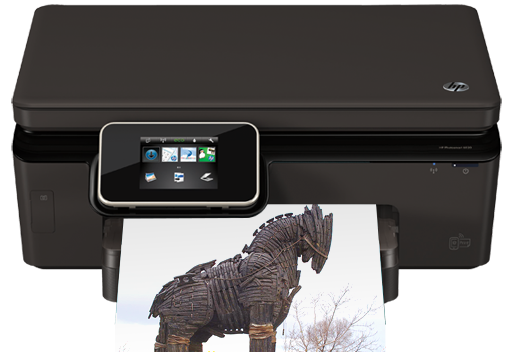The Iliad is the notorious story of the fall of the Troy to the Greeks in the Trojan War. Regardless of heroes like Achilles or Hector, the war was eventually won with the most unsuspecting tool, the Trojan Horse. Disguised as a victory trophy for the Trojans, the hollowed out horse was used to sneak past Trojan defense lines for the Greeks to end the war.
This successful strategy has become an infamous symbol in modern days for tech threats just as massive and deadly. Our threat up for discussion today? The standard office network printer. Here are some common Trojan Horses found within printing environments.

Printer Perils
Document Theft - For the vast majority of offices, network printers are established in an area where it is easy to gain access. Anyone can simply walk over to a printer and pick up sensitive documents that someone else printed. If your printer contains sensitive media such as bank checks, consider locking your paper trays.
Settings - In an effort to keep things simple most companies don’t secure the controls on the printer. This gives an opportunity for someone to either purposefully or accidentally reroute print jobs, open saved copies of documents, or reset factory defaults creating technical problems, and damaging productivity.
Internal Storage - Some printers have an internal storage, saving print jobs, scans, and copies. If someone has the gall to steal your network printer, they can have access to that material. However the most likely scenario is that if you replace a printer and don’t properly erase the data, it could fall into the wrong hands.
Eavesdropping on the Network - Hackers can eavesdrop on the traffic and capture documents going to or from the printer, and even spool all print jobs out to a remote listener in the cloud.
Internet Access - As printers have become more sophisticated, we have elected to give them more access to additional resources for convenience. The internet gives hackers a buffet of options to attack your printer and network.
The good news is that knowing the problems that you might be facing gives you the advantage of taking the kinds of simple precautions needed to defeat a majority of the attacks, and defusing a potential Trojan Horse. These quick suggestions can help reduce the chances of being unprepared for an attack.
-
Upgrade older printers to ones with up to date security functions
-
Utilize password protection
-
Secure your printer admin traffic where possible
-
Properly erase and discard old printers
-
Monitor and manage your printing system by creating automated alerts, looking to managed print services, and creating controlled settings for end-users
